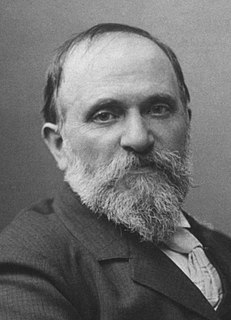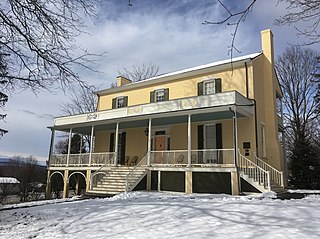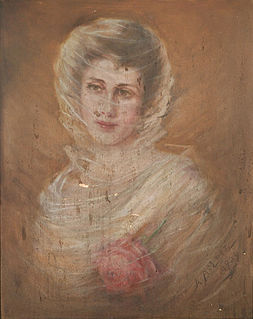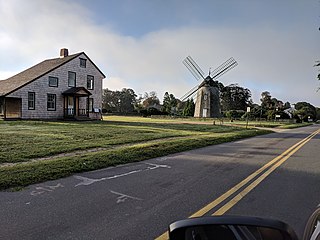
Thomas Moran was an American painter and printmaker of the Hudson River School in New York whose work often featured the Rocky Mountains. Moran and his family, wife Mary Nimmo Moran and daughter Ruth took residence in New York where he obtained work as an artist. He was a younger brother of the noted marine artist Edward Moran, with whom he shared a studio. A talented illustrator and exquisite colorist, Thomas Moran was hired as an illustrator at Scribner's Monthly. During the late 1860s, he was appointed the chief illustrator for the magazine, a position that helped him launch his career as one of the premier painters of the American landscape, in particular, the American West.

Thomas Hovenden, was an Irish artist and teacher who spent much of his life in the United States. He painted realistic quiet family scenes, narrative subjects and often depicted African Americans.

The Thomas Cole National Historic Site, also known as Cedar Grove, is a National Historic Landmark that includes the home and the studio of painter Thomas Cole, founder of the Hudson River School of American painting. It is located at 218 Spring Street, Catskill, NY, United States. The site provided Thomas Cole with a residence and studio from 1833 through his death in 1848.

The Fisher Fine Arts Library was the primary library of the University of Pennsylvania from 1891 to 1962. The red sandstone, brick-and-terra-cotta Venetian Gothic giant—part fortress and part cathedral—was designed by the acclaimed Philadelphia architect Frank Furness (1839–1912). The cornerstone was laid in October 1888, construction was completed in late 1890, and the building was dedicated in February 1891.
Historic preservation in New York is activity undertaken to conserve forests, buildings, ships, sacred Indian burial grounds, water purity and other objects of cultural importance in New York in ways that allow them to communicate meaningfully about past practices, events, and people. Governmental programs for historic preservation range from Federal ownership and active operation of sites to grants and subsidies provided by state government, municipal support of museums and interpretative displays. Nonprofit programs include activities of statewide and local historical associations and museums, and activities of historical societies and museums at the national level. Quasi-governmental organizations, such as the New York State Thruway Authority and Thousand Islands Bridge Authority, play a role as well. Private endeavors, such as investment and other choices made by private landowners to conserve historical features of their properties, are significant but less visible and include groups such as the Historic Districts Council, The New York Landmarks Conservancy and the Preservation League of New York State. During the reconstruction of the World Trade Center site in July 2010, a team of archaeologists discovered a 32-foot-long boat. The craft was at least 200 years old, dating from a time when the Hudson River was partly filled with trash and debris because of a rapidly expanding lower Manhattan.

The John Coltrane House is a historic house at 1511 North 33rd Street in Philadelphia, Pennsylvania, USA. A National Historic Landmark, it was the home of American saxophonist and jazz pioneer John Coltrane from 1952 until 1958. On his death in 1967 the house passed to his cousin, who sold it in 2004. Efforts for restoration and reuse as a jazz venue are ongoing as of 2013.

The Edgar Allan Poe Cottage is the former home of American writer Edgar Allan Poe. It is located on Kingsbridge Road and the Grand Concourse in the Fordham neighborhood of the Bronx, New York, a short distance from its original location, and is now in the northern part of Poe Park.

Millford Plantation is a historic forced-labor farm and plantation house located on SC 261 west of Pinewood, South Carolina. It was sometimes called Manning's Folly, because of its remote location in the High Hills of Santee section of the state and its elaborate details. Designated as a National Historic Landmark, it is regarded as one of the finest examples of Greek Revival residential architecture in the United States. The house has been restored and preserved along with many of its original Duncan Phyfe furnishings.

The Winslow Homer Studio is the historic studio and home of the artist Winslow Homer, which is located on what is now Winslow Homer Road on Prouts Neck in Scarborough, Maine. Maine architect John Calvin Stevens altered and expanded an existing carriage house to suit Homer's needs in 1884, even moving the building 100 feet for added privacy from his brother's neighboring summer home. The most dramatic element is a balcony the width of the building, from which the artist often painted in winter. The building is 44 by 53 feet and two stories high, for a total of 2,200 square feet (200 m2). Homer lived and painted in the studio from 1884 until his death there in 1910.

East Hampton Village District is a historic district in East Hampton, New York.

Mary Nimmo Moran was an American 19th-century landscape printmaker, specializing in etchings. She completed roughly 70 landscape etchings, which included scenes of England and Scotland, as well as Long Island, New York; New Jersey, Florida and Pennsylvania. In 1881, she was one of eight Americans and the first female elected as a fellow to London's Royal Society of Painter-Etchers. Mary Nimmo Moran's landscape View of Newark from the Meadows is in the collection of The Newark Museum of Art.

Blackwell Island Lighthouse, now known as Roosevelt Island Lighthouse, also was known as Welfare Island Lighthouse, is a stone lighthouse built by the government of New York City in 1872. It is within Lighthouse Park at the northern tip of Roosevelt Island in the East River. It was named to the National Register of Historic Places on March 16, 1972 and was designated a New York City Landmark on March 23, 1976.

The Pantigo Road Historic District is a historic district in the Village of East Hampton, on Long Island, New York. It is located on a segment of New York State Route 27 named Pantigo Road, and was listed on the National Register of Historic Places on July 21, 1988.

The Ramey House, sometimes also called the Ramey–Grainger house, is a privately owned, early 20th-century Colonial Revival home and historic landmark located at 605 South Broadway Avenue in Tyler, Texas, occupying the southwest corner of Broadway Avenue and Houston Street. It was built in 1903 by its namesake, Thomas Brown Ramey, who was a Tyler businessman and jeweler. Ramey and his wife, Mary Josephine Ramey, were well-known locally for their civic engagement and public commitments.

Adelia Armstrong Lutz was an American artist active in the late nineteenth and early twentieth centuries. She organized art circles in Knoxville, Tennessee, as director of the Knoxville Art Club and as a co-organizer of the Nicholson Art League. Her still lifes and portraits were exhibited throughout the American South, and they are to be the subject of a permanent exhibit at her former home, Historic Westwood.

Peter M. Wolf is an American author, land planning and urban policy authority, investment manager, and philanthropist. He lives in New York City.

The mill cottage on the Lion Gardiner farm at 36 James Lane on the landmarked East Hampton Village green has become a museum displaying 19th and early-20th-century landscape paintings. It is a contributing structure on the NRHP East Hampton Village District, replacing the original cottage on the lot situated with the windmill and Rev James historic marker.






















